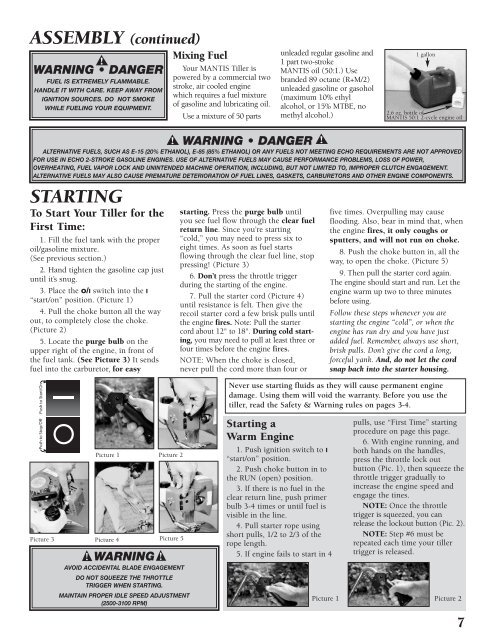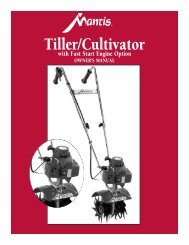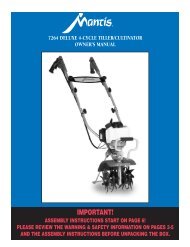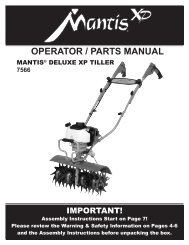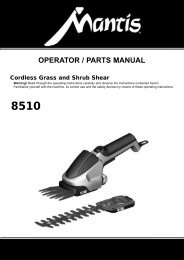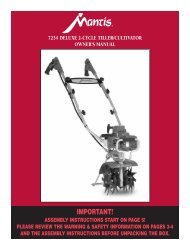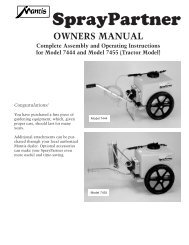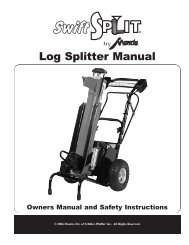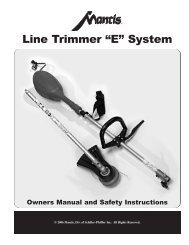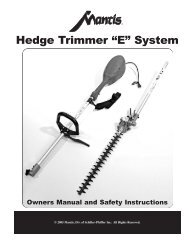Tiller/Cultivator
Owner's Manual - Mantis
Owner's Manual - Mantis
- No tags were found...
Create successful ePaper yourself
Turn your PDF publications into a flip-book with our unique Google optimized e-Paper software.
401710 <strong>Tiller</strong> Red 20pgs_???code <strong>Tiller</strong> Grn 5/24/10 11:05 AM Page 7<br />
ASSEMBLY (continued)<br />
!<br />
WARNING • DANGER<br />
FUEL IS EXTREMELY FLAMMABLE.<br />
HANDLE IT WITH CARE. KEEP AWAY FROM<br />
IGNITION SOURCES. DO NOT SMOKE<br />
WHILE FUELING YOUR EQUIPMENT.<br />
Mixing Fuel<br />
Your MANTIS <strong>Tiller</strong> is<br />
powered by a commercial two<br />
stroke, air cooled engine<br />
which requires a fuel mixture<br />
of gasoline and lubricating oil.<br />
Use a mixture of 50 parts<br />
unleaded regular gasoline and<br />
1 part two-stroke<br />
MANTIS oil (50:1.) Use<br />
branded 89 octane (R+M/2)<br />
unleaded gasoline or gasohol<br />
(maximum 10% ethyl<br />
alcohol, or 15% MTBE, no<br />
methyl alcohol.)<br />
1 gallon<br />
2.6 oz. bottle of<br />
MANTIS 50:1 2-cycle engine oil<br />
!<br />
WARNING • DANGER<br />
ALTERNATIVE FUELS, SUCH AS E-15 (20% ETHANOL), E-85 (85% ETHANOL) OR ANY FUELS NOT MEETING ECHO REQUIREMENTS ARE NOT APPROVED<br />
FOR USE IN ECHO 2-STROKE GASOLINE ENGINES. USE OF ALTERNATIVE FUELS MAY CAUSE PERFORMANCE PROBLEMS, LOSS OF POWER,<br />
OVERHEATING, FUEL VAPOR LOCK AND UNINTENDED MACHINE OPERATION, INCLUDING, BUT NOT LIMITED TO, IMPROPER CLUTCH ENGAGEMENT.<br />
ALTERNATIVE FUELS MAY ALSO CAUSE PREMATURE DETERIORATION OF FUEL LINES, GASKETS, CARBURETORS AND OTHER ENGINE COMPONENTS.<br />
STARTING<br />
To Start Your <strong>Tiller</strong> for the<br />
First Time:<br />
1. Fill the fuel tank with the proper<br />
oil/gasoline mixture.<br />
(See previous section.)<br />
2. Hand tighten the gasoline cap just<br />
until it’s snug.<br />
3. Place the o/I switch into the I<br />
“start/on” position. (Picture 1)<br />
4. Pull the choke button all the way<br />
out, to completely close the choke.<br />
(Picture 2)<br />
5. Locate the purge bulb on the<br />
upper right of the engine, in front of<br />
the fuel tank. (See Picture 3) It sends<br />
fuel into the carburetor, for easy<br />
starting. Press the purge bulb until<br />
you see fuel flow through the clear fuel<br />
return line. Since you’re starting<br />
“cold,” you may need to press six to<br />
eight times. As soon as fuel starts<br />
flowing through the clear fuel line, stop<br />
pressing! (Picture 3)<br />
6. Don’t press the throttle trigger<br />
during the starting of the engine.<br />
7. Pull the starter cord (Picture 4)<br />
until resistance is felt. Then give the<br />
recoil starter cord a few brisk pulls until<br />
the engine fires. Note: Pull the starter<br />
cord about 12" to 18". During cold start -<br />
ing, you may need to pull at least three or<br />
four times before the engine fires.<br />
NOTE: When the choke is closed,<br />
never pull the cord more than four or<br />
!<br />
five times. Overpulling may cause<br />
flooding. Also, bear in mind that, when<br />
the engine fires, it only coughs or<br />
sputters, and will not run on choke.<br />
8. Push the choke button in, all the<br />
way, to open the choke. (Picture 5)<br />
9. Then pull the starter cord again.<br />
The engine should start and run. Let the<br />
engine warm up two to three minutes<br />
before using.<br />
Follow these steps whenever you are<br />
starting the engine “cold”, or when the<br />
engine has run dry and you have just<br />
added fuel. Remember, always use short,<br />
brisk pulls. Don’t give the cord a long,<br />
forceful yank. And, do not let the cord<br />
snap back into the starter housing.<br />
Never use starting fluids as they will cause permanent engine<br />
damage. Using them will void the warranty. Before you use the<br />
tiller, read the Safety & Warning rules on pages 3-4.<br />
!<br />
Picture 1 Picture 2<br />
Picture 3 Picture 4 Picture 5<br />
WARNING<br />
AVOID ACCIDENTAL BLADE ENGAGEMENT<br />
DO NOT SQUEEZE THE THROTTLE<br />
TRIGGER WHEN STARTING.<br />
MAINTAIN PROPER IDLE SPEED ADJUSTMENT<br />
(2500-3100 RPM)<br />
!<br />
Starting a<br />
Warm Engine<br />
1. Push ignition switch to I<br />
“start/on” position.<br />
2. Push choke button in to<br />
the RUN (open) position.<br />
3. If there is no fuel in the<br />
clear return line, push primer<br />
bulb 3-4 times or until fuel is<br />
visible in the line.<br />
4. Pull starter rope using<br />
short pulls, 1/2 to 2/3 of the<br />
rope length.<br />
5. If engine fails to start in 4<br />
pulls, use “First Time” starting<br />
procedure on page this page.<br />
6. With engine running, and<br />
both hands on the handles,<br />
press the throttle lock out<br />
button (Pic. 1), then squeeze the<br />
throttle trigger gradually to<br />
increase the engine speed and<br />
engage the tines.<br />
NOTE: Once the throttle<br />
trigger is squeezed, you can<br />
release the lockout button (Pic. 2).<br />
NOTE: Step #6 must be<br />
repeated each time your tiller<br />
trigger is released.<br />
Picture 1 Picture 2<br />
7


